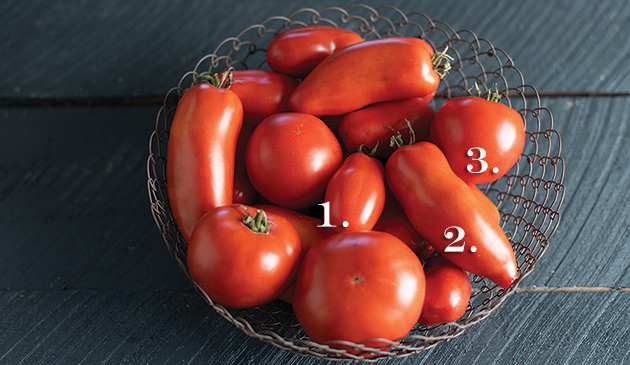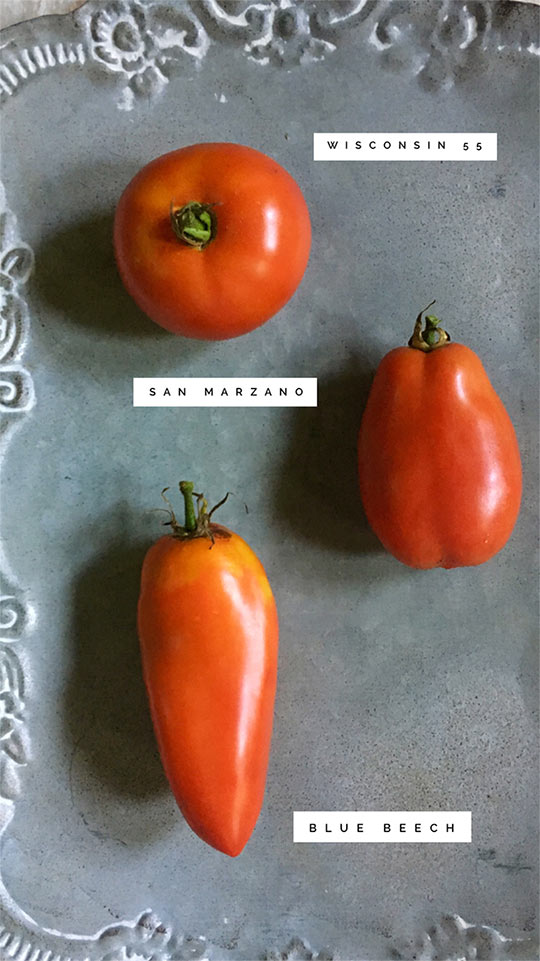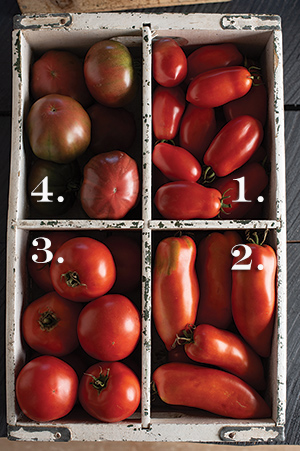- Johnny's Research Farm | Breeding, Trialing, Selection & Quality Assurance
- Johnny’s OP Stewardship Project: Restoration of ‘Hungarian Hot Wax’ Pepper
- Open-Pollinated Revival Project: 3 Improved OP Heirloom & Heritage Tomatoes
- A Brief History of Tool Development at Johnny's | Planting the Seed of a Small-Scale Farming Revolution
- Classical Plant Breeding at Johnny's | by Rob Johnston, Jr, Plant Breeder (Retired) & Founder of Johnny's Selected Seeds
- 5 JSS-Bred Varieties Introduced by Rob Johnston, Jr., Plant Breeder & Founder (Retired), Johnny's Selected Seeds
- 3 for 2020: New Johnny-Bred Stories by Rob Johnston, Jr. | ‘Starry Night,’ ‘Citrine’ & ‘Pipsqueak’
- Classical Plant Breeding at Johnny's Selected Seeds | Infographic
- About Johnny's Variety Trialing Program
- Seed Variety Trialing – Why Try Something New?
- Seed Variety Trialing at Johnny's Selected Seeds | Infographic
- Johnny's-Bred Kabocha Winter Squash Timeline | Infographic
- How to Conduct a Scale-Appropriate Trial on Your Own Farm
- All-America Selections Award-Winning Varieties Bred by Johnny's | Spec Sheet
- Varieties Bred by Johnny's | 4-pp Brochure
- About Johnny's | PDF
- Johnny's Announces 'Rhubarb Supreme' | New Bolt-Resistant Strain of a Favorite, Open-Pollinated Swiss Chard | Press Release
- Johnny's Corno di Toro Peppers Rule | Press Release
- Pea Selection at Johnny's | The Story of 'Sugar Ann' Snap Pea
- The Johnny's Advantage | PDF
- Video: Classical Plant Breeding at Johnny's
- Video: 'Cherry Bomb' | JSS-Bred Organic Cherry x Grape Tomato from Johnny's
- Video: Johnny's Trialing Program
- Video: Hand-Pollinating Peppers at Our Research Farm | Classical Plant Breeding at Johnny's Selected Seeds
- Video: 'Clementine' | The Tangerine-Colored, Organic Cocktail Tomato from Johnny's Breeding Team
- Johnny’s Selected Seeds Observes 50th Anniversary | Press Release
- Johnny's Welcomes Kevin L Cook, PhD as VP of R&D | Press Release
- Video: Restoration of OP 'Hungarian Hot Wax' Pepper | Exclusively from Johnny's Selected Seeds
- Farm Tours of Johnny's Research & Trialing Farm
Breathing New Life into Time-Worn Gifts from the Past
As a plant breeder at Johnny's, my job was to help imagine the future of our food system and feed this vision with new varieties. But the work of a plant breeder is less like scrying into a crystal ball than solving a riddle for the ages that has been passed down through generations. We inherit the puzzle, and the work, of those who came before us. Then we stand on the shoulders of these giants, weaving their legacy into a new history of our own design.
Though plant breeders have no shortage of grower problems to solve or new directions to explore, one thing is certain: we are already heirs to a collective fortune. One cannot naïvely dismiss heirlooms and other "old-fashioned" open-pollinated (OP) varieties as relics of the past. These "relics" are our heritage as well as the vital building blocks of breeding programs. They reflect our past and help lay the foundation for a better future. In this way, they are really more like gifts of the past than relics.
One of the best parts of this job is unearthing these gifts. Each year in the breeding nursery, Johnny's grows just some of the cornucopia of older varieties that remain, in search of different traits that could prove valuable if incorporated into our germplasm. Sometimes varieties or unique strains are discovered that are already quite special in their own right: gifts that are worth saving and sharing with future generations — despite the flaws which leave the next generation of plant breeders room for improvement — because of the exceptional qualities they do preserve.
3 Revived Open-Pollinated Strains Selected by Us for You
It is our pleasure to offer three of these gifts to you in our catalog: 'San Marzano II,' 'Blue Beech,' and 'Wisconsin 55'. Each of these open-pollinated varieties was selected because of its unique history, outstanding quality, and adaptability to short seasons or low-input environments.
Let's take a closer look at these three gems.
1 • San Marzano II
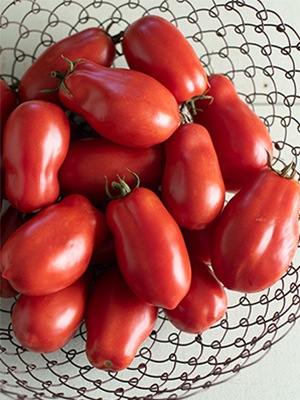
'San Marzano' is considered one of the best, most flavorful paste tomatoes of all time. Whole tomatoes peel easily, and cook down to sauce quickly.
Various strains of 'San Marzano' exist; this particular strain came from the USDA gene bank, an institution established in 1958 to preserve genetic diversity and increase food security. The strain originates, however, from Parma, Italy, where it was developed for the 1950's canning industry.
Compared to other 'San Marzano' strains we've tested, the fruits borne on this strain have outstanding flavor and a very traditional 'San Marzano' shape, as well as a more vibrant red color.
(Indeterminate, 78 days.)
2 • Blue Beech
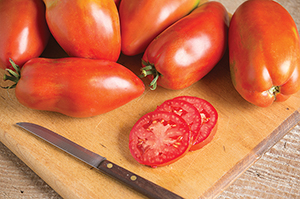
'Blue Beech' is an heirloom variety known as a "sausage-" or "pepper-type" paste tomato — producing large, elongated fruits that are easy to process into sauce. While it makes for an excellent canning tomato, it also has very good fresh eating quality.
This variety was originally brought from Italy during WWII; its name is said to derive from the Vermont farm where it was first introduced to the U.S.
'Blue Beech' is well-adapted to cooler, northern climates and resists disease and blossom end rot better than most heirloom sausage types we tested.
(Indeterminate, 82 days.)
3 • Wisconsin 55
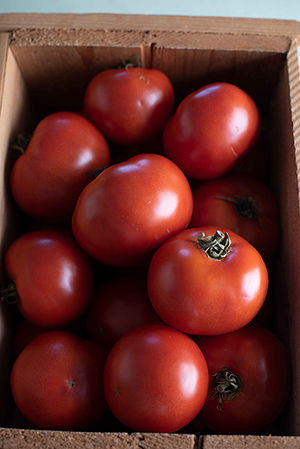
'Wisconsin 55' is a popular OP variety developed at the University of Wisconsin, Madison that has been a workhorse with farmers' market growers for over 60 years. A great slicer for fresh eating, but also well-suited to canning, especially stewed tomatoes.
Along with its classic tomato flavor, 'Wisconsin 55' offers some tolerance to early blight and Septoria leaf spot.
There are several strains available, many of which have drifted away from the original and changed over time. The strain we offer is a rare, older source that we acquired from the University of Wisconsin, Madison plant geneticist, Ted Bingham, who had frozen seed that was purchased in the 1960's. This strain produces healthier plants and more consistently sized fruits with fewer plant defects than other commercially available strains.
(Indeterminate, 80 days.)
Don't Just Take Our Word for It — Tell It Like It Is!
We'd like to share some of the love we've already received from our grower-partners about these three gems. Come next season, we hope you'll join us in hash-tagging #GrowWithJohnnys on shots of your own plants and fruits from these OP varieties. Most of all, we hope you'll enjoy sharing and savoring the abundantly rich, flavorful eating experiences — the fresh and sun-dried slices, slivers, and salsas, the gently simmered sauces, pastes, and jams — that come of them.
View all our open-pollinated tomatoes…
Learn More
Learn more about Johnny's classical plant breeding program, our certified-organic research and trialing farm, and the different types of seeds we produce and offer.
3 IMPROVED TOMATOES from OUR OPEN-POLLINATED PROJECT:
1 • 'San Marzano II'
2 • 'Blue Beech'
3 • 'Wisconsin 55'
LEARN MORE

& Former Johnny's Plant Breeder
Emily Rose Haga served at Johnny's as the next-generation tomato and pepper breeder from 2012–2019, carrying on the great work of retired plant breeders Rob Johnston, Jr. and Janika Eckert.
Haga's interest in plants germinated at a young age while listening to stories about her Grandma Rose's early life in rural Appalachia, raising and preserving her family's own food off the land.
She shared many inspiring years gardening and cooking with her grandma, developing her own love of food traditions and growing things. This in turn inspired her to pursue work at food co-ops and organics farms in Southern Wisconsin, before deciding to pursue degrees in Horticulture and Plant Breeding & Genetics from the University of Wisconsin–Madison.
At university she discovered a like-minded community of public plant breeders and other researchers, right in her own backyard, dedicated to solving problems and improving varieties for growers. After getting her hands dirty and working with a wide range of specialty crops, Haga knew she had found her life's passion: helping to improve the viability of diversified farming systems and revitalize local food and farming communities through the role of seeds and breeds.
While at Johnny's, Haga specialized in developing unique and flavorful new tomato and peppers, with adaptations needed by growers in short-season and low-input/organic environments. As Executive Director at Seed Savers Exchange, she continues to nurture an immense respect for the rich diversity of food crops domesticated by our human ancestors, and the heritage they have preserved and passed on for future generations.


